We are working towards our carbon neutral ambition across several projects to reduce carbon across our operations, and to offset (within the borough) the emissions we can’t eliminate completely.
The case studies below provide more information on completed projects as we work towards becoming carbon neutral by 2025.
The following checkboxes are used for accordion drop-downs. When selected, they show content that was visually hidden
Cheshire East Council has worked alongside Alderley Park to develop a decarbonised solution for the district heating scheme, culminating in a newly developed renewable, low carbon heating system for the site. This has been achieved through initially optimising the existing heat network to enable future development of a fifth generation ambient loop driven by ground sourced heat. Alderley Park has rebuilt the energy centre to accommodate changes to operations and improved the pipework across the site
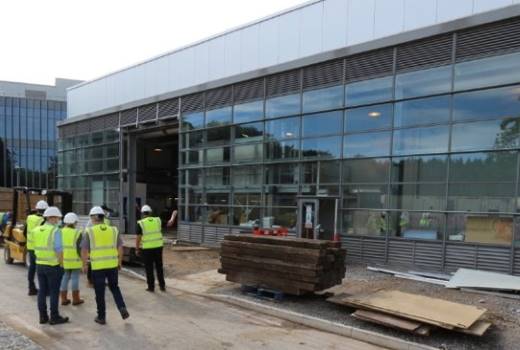
Background
Bruntwood Ltd manage the site under their new ambition to be net zero for all new buildings by 2030. In accordance with this pledge, Bruntwood Ltd has invested approximately £12 million to improve the current energy system. A new combined heat and power unit has been installed on site which will save more than 1,000 tonnes of CO2 per annum. Bruntwood Ltd plan to explore further opportunities for large scale solar primarily on rooftops, alongside integration of electrical vehicle charging infrastructure in a further push towards decarbonisation. This project was supported by Cheshire East Council’s energy programme, with UK Government and European Investment Bank support.
Project objectives
- Establish Alderley Park as an exemplar site for sustainability and green innovation to meet Bruntwood’s net zero ambition
- Attract inward investment
- Enhance the site’s attractiveness for more businesses to relocate, thereby supporting the park’s sustainable growth long term
- Future proofing the site to create a secure employment hub
- Supporting the government’s commitments to prioritise climate change impacts and reduce carbon consumption.
- Reduce energy costs (payback within 3 years)
Hydro-electric generation: Community led project
Congleton Hydro is one of the first community-based generation schemes within Cheshire East. The project, which will utilise waterpower from the River Dane by installing a 64kW turbine, will produce enough clean, green energy to power the equivalent of 60 homes.
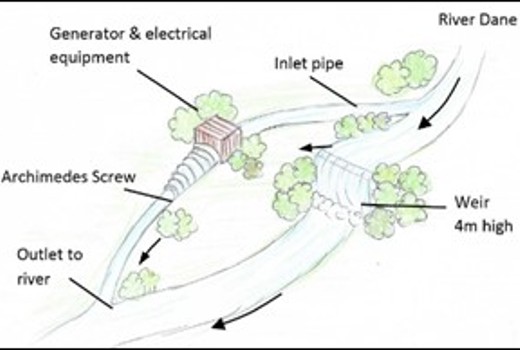
The installation will include a 2.5m diameter, 8m long Archimedes screw which will drive the 75kW electrical generator. Once generated, the power will be transported through a 1000m cable to the Siemens factory.
It is hoped that this project will provide the necessary drive for other environmentally conscious local companies and institutions to get involved.
Background information
Dane Valley Community Energy (DVCE) is a not-for-profit organisation consisting of professional, skilled and environmentally conscious volunteers. DVCE will install and operate the hydro-electric generation plant on the River Dane, at Havannah Weir. The weir, which has been in place for more than 250 years, will now be used to generate energy from rainwater – providing a renewable, greener form of energy generation. The project has successfully secured funding using a community shared ownership scheme organised by Share Energy.
Expected project outcomes
- 275kWh carbon-free electricity generation per year, reducing Cheshire East’s CO2 emissions and reliance on fossil fuels for energy generation.
- Projected surplus of approximately £5,000 per year – to be used to fund other local community projects.
- Opportunity to raise awareness of environmental issues and offers an exceptional educational resource for local schools.
- Maintains Congleton’s industrial heritage Carbon Neutral Update 2021Congleton Hydro, DVCF (2020)
Case Study: Heat networks
Cheshire East Council committed itself to becoming carbon neutral for its own operations by 2025, and to using its influence within the wider borough to reduce carbon and improve sustainability. It is recognised that the need to heat spaces is one of the greatest issues to overcome in reducing carbon emissions. Cheshire East Council is working to develop heat networks in various forms to give the borough the best base to transition away from gas as a primary heat source in public, industrial and domestic buildings.
Crewe Town Centre heat network
This network is currently within the procurement and pre-construction services phase. A network intending to eventually connect four buildings owned by Cheshire East Council and potentially other publicly used buildings. Powered by a combination of a gas fired combined heat and power engine and an air source heat pump the network will initially provide carbon savings circa 350tCO2e per annum, however, as the technologies and their economics improve, the replacement energy sources are expected to reduce the carbon intensity of the network towards an eventual zero over time. Due to the difficulties experienced in the retrofit of existing buildings, including two listed buildings, this project has required significant grant funding to be economically viable. Once in place the network will provide a heat resource capable of expansion and therefore providing heat security for a rapidly developing town centre.
Alderley Park Heat Network
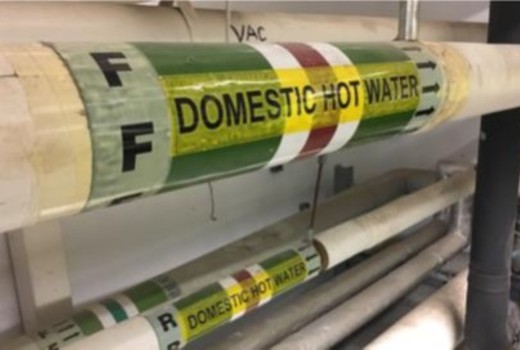 Fully delivered heat network servicing the Alderley Park campus in Cheshire East is a prime example of co-operation between the local authority and local businesses.
Fully delivered heat network servicing the Alderley Park campus in Cheshire East is a prime example of co-operation between the local authority and local businesses.- Alderley Park partnered with Cheshire East Council to develop the network and successfully obtained Heat Network Development Unit funding.
- This network was developed to optimise one already in existence to reduce waste heat and carbon emissions. While the heat source remains natural gas powering combined heat and power units the network will show a carbon reduction of over 200 tCO2e per annum over forty years and provide the science park with a significant financial saving.
Garden Village heat network
- An area of difficulty for the decarbonisation of heat is the domestic dwelling sector, particularly in areas of low density. Cheshire East Council is in the process of developing a garden village in the north of the borough to provide an entirely new settlement.
- Whilst providing a low density of housing, Cheshire East Council undertook an initial feasibility and detailed design studies which discovered high confidence that a heat network servicing the settlement and powered by ground source heat pumps located in a central energy centre can provide all the space heating and hot water for the site.
- This network is expected to provide a carbon saving as well as a financial saving to residents
Overview of the hydrogen project
The hydrogen project was designed as a three-year demonstration project, with the principal aim to reduce carbon emissions within the waste collection services across Cheshire and Warrington. Working together with Storengy UK and Ansa Environmental Services, alongside support from the Cheshire and Warrington Local Enterprise Partnership, a green hydrogen production facility has been built at the council’s Environmental Hub in Middlewich. Initially, this will provide clean, green hydrogen fuel to two Cheshire East refuse collection vehicles (RCVs) and a 4x4 vehicle owned by Storengy.
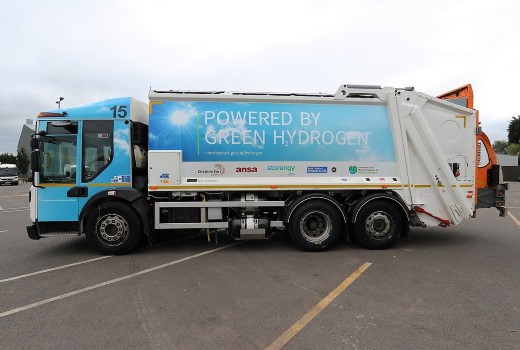
Background of the hydrogen project
Last year the government produced its ‘Ten-point plan for a green industrial revolution’, which promoted both the use of hydrogen as a clean fuel for the future and accelerating the shift to zero emission vehicles – including the use of hydrogen for heavy goods vehicles. The unique energy transport and storage capacity properties provided by hydrogen make it a potential solution for the decarbonisation of long range and heavy transport. The hydrogen project contributes towards that transition as part of the low carbon economy, providing the project partners with the opportunity to become accustomed to the creation, storage and use of green hydrogen in a practical way – accelerating the future adoption of hydrogen technologies. The project will also deliver the tangible benefits of decarbonisation, air quality improvements and creating green jobs and growth.
Hydrogen project objectives
- Reduce carbon emissions from waste collection – contributing to Cheshire East’s carbon neutral by 2025 target.
- Build capacity and understanding in the use, management and storage of hydrogen within the project partners.
- Support green jobs and growth through upskilling workers, and safeguarding employment in vehicle and gas technologies.
- Facilitate improvements in air quality using hydrogen, as part of our air quality strategy, and reducing fuel transport to the site.
- Raise awareness of hydrogen and the climate emergency among the public and school children (the two hydrogen RCVs were named ‘Chewie’ and ‘Chomper’ following a primary school competition).
Cheshire East Council committed to becoming carbon neutral in its own operations by 2025, but also to using its influence within the wider borough to reduce carbon and improve sustainability. Several initiatives are already underway to engage and empower the community to improve the carbon footprint of their activities and understand the scale of the challenge we face.
Town and parish council toolkit and hub
Many of our local councils have approached us for assistance in meeting their own climate targets. With the help of Anthesis, we have developed a toolkit for our town and parish councils to use to calculate and reduce their current carbon output. To encourage further collaboration between the councils and to facilitate the sharing of ideas and expertise we have also developed our climate hub. This is an online collaboration platform for use by members of our town and parish councils or their related sustainability groups. In addition to providing easy access to the toolkit, the hub functions as a social platform to allow sharing of news articles, examples of best practice or requests for help and assistance.
School competitions
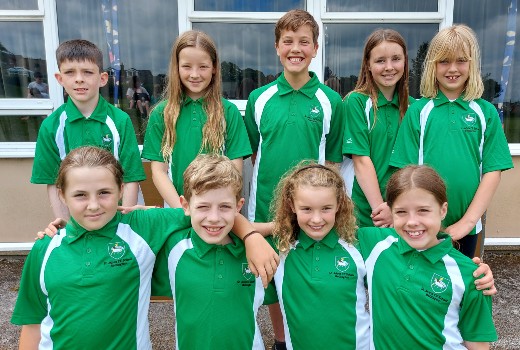
We recognise that bringing young people into the climate conversation has never been more important.
Our competition to ‘Name the hydrogen bin trucks’, run in partnership with Storengy UK and Ansa Environmental Services, received a huge amount of interest from primary school children across the borough. The winning names, selected by a judging panel including our members and project partners, were CH2ewie and CH2omper.
In another competition, launched with Storengy UK, we asked primary school children to submit creative ideas for tackling climate change – and received an amazing response. The winning school received a prize of a solar panel package for their school worth up to £10,000, with prizes of solar panel robot kits being delivered to the well-deserved runners-up.
Reaseheath conference
To provide the most comprehensive community engagement, the council recognises the need to make contact with many different sectors. Partnering with Sustainability Nantwich and Reaseheath College, with support from the Cheshire and Warrington Local Enterprise Partnership, we hosted a virtual conference in October 2021.
The primary purpose of the conference was to engage different sectors with the climate conversation, particularly agriculture and retail.
Having secured Sir Jonathon Porritt, a British environmentalist and journalist as the keynote speaker, the conference sought to inform but, more importantly, be informed by the sector representatives. As a council, we need to understand the constraints and difficulties, but also the potential of each sector within our borough – encouraging a collaborative approach to carbon reduction and sustainability.
A key aspect of Cheshire East’s commitment to achieving carbon neutrality by 2025 is enhancing and protecting the borough’s natural capital.
Delivering nature-based initiatives such as tree planting, peatland restoration or habitat regeneration allows us to offset carbon which cannot be eliminated by other means.
Crucially, we have engaged relevant landowners regarding maximising the potential for tree planting, soil management and conservation of peatlands. The enhancement of natural capital is also an opportunity to connect with wider community groups – engaging with local people and establishing positive relationships will encourage sustained support for community projects.
Background of the project
The adoption of the new environment strategy in 2019 laid the foundation for the emergence of the carbon neutral action plan in 2020. The plan sets targets for maximising the potential for carbon sequestration through developing natural capital within the borough.
Part of the plan states the council’s aim to sequester carbon on at least 100 hectares of council owned land by 2025, coupled with aims to develop natural climate solutions for carbon sequestration on between 41 and 1,347 hectares of non-council owned land by 2025.
The management, investment and restoration of the natural environment will strengthen the borough’s resilience against climate change impacts in the long term.
Examples of project work
Tree planting
- Following collaborations with The Mersey Forest, Cheshire Wildlife Trust and Ansa Environmental Services, we have successfully planted 22 hectares of trees across the borough since 2019. Native, broadleaved species have been used within public parks, school grounds, community spaces and grass verges to successfully increase capacity for carbon sequestration.
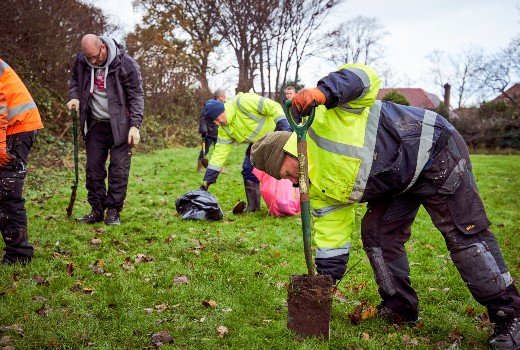
Leighton Grange
- A recent collaboration with The Mersey Forest and the Green Task Force saw Cheshire East complete its first large-scale tree planting project with 7 hectares planted within one week.
- This project was funded by the Trees for Climate fund – a multi-million pound woodland creation programme and part of the government-led Nature for Climate Fund. High-quality woodlands will significantly contribution to the council’s carbon neutral commitment.
Peatland Restoration
Pastures Wood
- Cheshire East Council teamed up with Cheshire Wildlife Trust to deliver restoration works on 1 hectare of moss land which has been under significant pressure from peat removal and encroachment of birch scrub.
- The project raised the water levels and removed birch shrub to prevent the peat from drying out and oxidising - releasing CO2 into the atmosphere.
- The project has introduced a recolonization of sphagnum mosses which will capture CO2 by forming a new peat layer.
- This will be advantageous, preventing further oxidation of around 10,000 cubic metres of ‘fossil’ peat and future carbon sequestration.